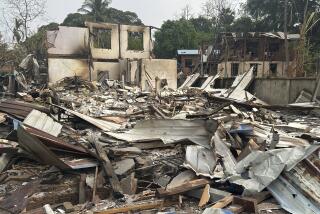700 Sri Lanka Civilians Reported Killed
- Share via
COLOMBO, Sri Lanka — A letter signed by prominent citizens in the besieged city of Jaffna charged Monday that “almost 700 innocent civilians are believed to have died” in nine days of fighting between Indian troops and Tamil separatist guerrillas.
Indian and Sri Lankan authorities said that 40 civilian refugees from Jaffna were killed Monday when a remote-controlled land mine was detonated under their bus. An Indian soldier escorting the bus was also killed in the explosion, which officials blamed on the Liberation Tigers of Tamil Eelam, the main Tamil separatist group.
“They must have confused it with a troop transport carrying Indian soldiers,” an official of the Sri Lankan government speculated.
Indian Commandos Advance
Meanwhile, according to an Indian spokesman in Madras, Indian commandos advanced from the old fort in Jaffna to link up with advancing ground units from the west. If so, this would leave less than a mile of coastline still in the hands of the separatist guerrillas.
The letter, signed by 12 prominent citizens, including the senior civil servant in the Jaffna district and the administrator of the main hospital, referred to “indiscriminate bombing and shelling and aerial strafing” by the Indian forces.
Indian officials have denied repeatedly that Indian forces are using offensive air power, citing fears of increased civilian casualties in the densely populated Jaffna peninsula.
Copies of the letter, addressed to Sri Lanka’s President Junius R. Jayewardene, were distributed through the Tamil Tiger group’s propaganda office in London. Among its signers were several known sympathizers with the Tamil Tigers’ goal--creation of an independent homeland for Tamils in the north and east of Sri Lanka.
Although the letter said almost 700 civilians “are believed to have died” in Jaffna, it reported only 76 bodies in the morgues of Jaffna area hospitals. The letter was consistent in parts with reports from refugees coming out of the Jaffna peninsula.
Refugees have said that the Indians had used aircraft in the offensive, as well as mortars a nd field artillery.
“Bombs, bombs, shells, shells, mortars, mortars--and terrible things going on all night,” said a Jaffna businessman who arrived Monday in Colombo, one of several thousand refugees who have left the war-torn peninsula.
He said that on one day he saw five Indian airplanes attack a guerrilla position in the city.
Other refugees mention Oct. 12 as a day of heavy air activity. Sri Lankan sources said the aircraft, including elements of the Sri Lankan air force, were called in after the Tamil Tigers trapped and killed 29 Indian commandos who had been landed by helicopter at the campus of Jaffna University.
Off-Limits to Press
Independent verification of these accounts is difficult. Indian authorities have made the peninsula off-limits to the press since the fighting began.
The bus was blown up Monday as Indian soldiers were attempting to escort the Tamil refugees to safety at Batticaloa, in Eastern province. The province’s population is 16% Tamil, 73% Sinhalese.
A Sri Lankan official disclosed, meanwhile, that the Indian army commander on the island, Maj. Gen. Harkirat Singh, has received a second cease-fire request from “Mahathiya” Mahendraraja, deputy commander of the guerrillas.
The official quoted Mahendraraja as saying that the Tigers would honor a cease-fire and turn over all their weapons except those needed for personal safety.
But the Sri Lankan official said that Indian and Sri Lankan military officers are becoming less interested in a negotiated settlement as the war continues. He said India has lost 128 soldiers in the fighting so far.
More to Read
Sign up for Essential California
The most important California stories and recommendations in your inbox every morning.
You may occasionally receive promotional content from the Los Angeles Times.













